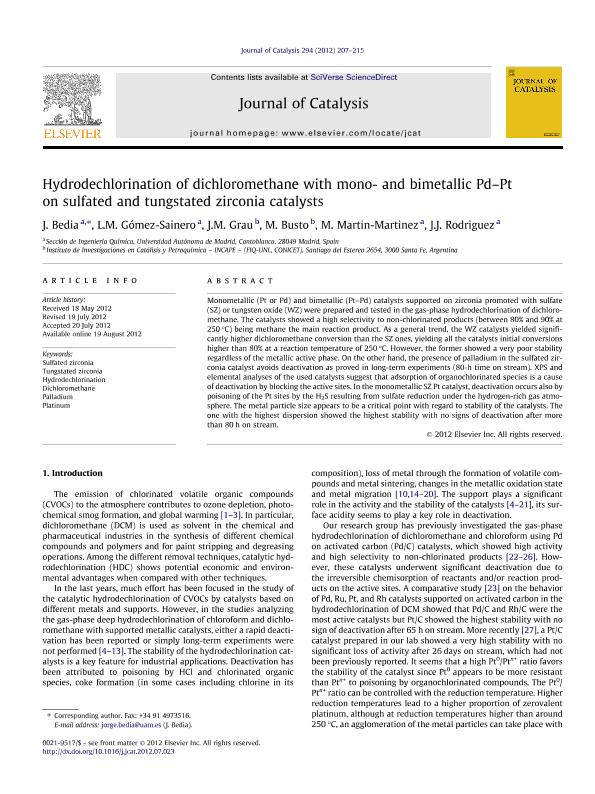Mostrar el registro sencillo del ítem
dc.contributor.author
Bedía, J.
dc.contributor.author
Gómez Sainero, L.M.
dc.contributor.author
Grau, Javier Mario

dc.contributor.author
Busto, Mariana

dc.contributor.author
Martín Martinez, M.
dc.contributor.author
Rodriguez Jimenez, J.J.
dc.date.available
2018-07-17T14:31:57Z
dc.date.issued
2012-07
dc.identifier.citation
Bedía, J.; Gómez Sainero, L.M.; Grau, Javier Mario; Busto, Mariana; Martín Martinez, M.; et al.; Hydrodechlorination of dichloromethane with mono- and bimetallic Pd-Pt on sulfated and tungstated zirconia catalysts; Academic Press Inc Elsevier Science; Journal of Catalysis; 294; 7-2012; 207-215
dc.identifier.issn
0021-9517
dc.identifier.uri
http://hdl.handle.net/11336/52362
dc.description.abstract
Monometallic (Pt or Pd) and bimetallic (Pt–Pd) catalysts supported on zirconia promoted with sulfate (SZ) or tungsten oxide (WZ) were prepared and tested in the gas-phase hydrodechlorination of dichloromethane. The catalysts showed a high selectivity to non-chlorinated products (between 80% and 90% at 250 C) being methane the main reaction product. As a general trend, the WZ catalysts yielded significantly higher dichloromethane conversion than the SZ ones, yielding all the catalysts initial conversions higher than 80% at a reaction temperature of 250 C. However, the former showed a very poor stability regardless of the metallic active phase. On the other hand, the presence of palladium in the sulfated zirconia catalyst avoids deactivation as proved in long-term experiments (80-h time on stream). XPS and elemental analyses of the used catalysts suggest that adsorption of organochlorinated species is a cause of deactivation by blocking the active sites. In the monometallic SZ Pt catalyst, deactivation occurs also by poisoning of the Pt sites by the H2S resulting from sulfate reduction under the hydrogen-rich gas atmosphere. The metal particle size appears to be a critical point with regard to stability of the catalysts. The one with the highest dispersion showed the highest stability with no signs of deactivation after more than 80 h on stream.
dc.format
application/pdf
dc.language.iso
eng
dc.publisher
Academic Press Inc Elsevier Science

dc.rights
info:eu-repo/semantics/openAccess
dc.rights.uri
https://creativecommons.org/licenses/by-nc-sa/2.5/ar/
dc.subject
Sulfated Zirconia
dc.subject
Tungstated Zirconia
dc.subject
Hydrodechlorination
dc.subject
Dichloromethane
dc.subject
Palladium
dc.subject
Platinum
dc.subject.classification
Otras Ingeniería Química

dc.subject.classification
Ingeniería Química

dc.subject.classification
INGENIERÍAS Y TECNOLOGÍAS

dc.title
Hydrodechlorination of dichloromethane with mono- and bimetallic Pd-Pt on sulfated and tungstated zirconia catalysts
dc.type
info:eu-repo/semantics/article
dc.type
info:ar-repo/semantics/artículo
dc.type
info:eu-repo/semantics/publishedVersion
dc.date.updated
2018-07-11T14:10:02Z
dc.journal.volume
294
dc.journal.pagination
207-215
dc.journal.pais
Países Bajos

dc.journal.ciudad
Amsterdam
dc.description.fil
Fil: Bedía, J.. Universidad Autónoma de Madrid. Facultad de Ciencias; España
dc.description.fil
Fil: Gómez Sainero, L.M.. Universidad Autónoma de Madrid. Facultad de Ciencias; España
dc.description.fil
Fil: Grau, Javier Mario. Consejo Nacional de Investigaciones Científicas y Técnicas. Centro Científico Tecnológico Conicet - Santa Fe. Instituto de Investigaciones en Catálisis y Petroquímica ; Argentina
dc.description.fil
Fil: Busto, Mariana. Consejo Nacional de Investigaciones Científicas y Técnicas. Centro Científico Tecnológico Conicet - Santa Fe. Instituto de Investigaciones en Catálisis y Petroquímica ; Argentina
dc.description.fil
Fil: Martín Martinez, M.. Universidad Autónoma de Madrid. Facultad de Ciencias; España
dc.description.fil
Fil: Rodriguez Jimenez, J.J.. Universidad Autónoma de Madrid. Facultad de Ciencias; España
dc.journal.title
Journal of Catalysis

dc.relation.alternativeid
info:eu-repo/semantics/altIdentifier/url/http://www.sciencedirect.com/science/article/pii/S002195171200228X
dc.relation.alternativeid
info:eu-repo/semantics/altIdentifier/doi/http://dx.doi.org/10.1016/j.jcat.2012.07.023
Archivos asociados
